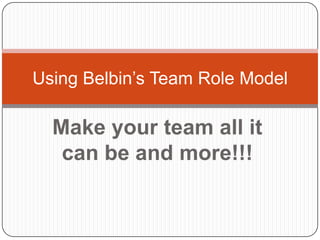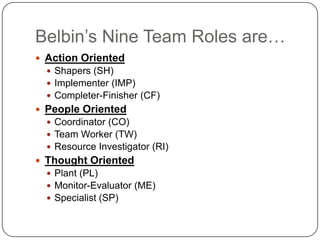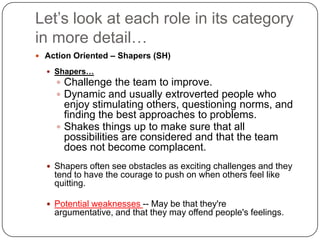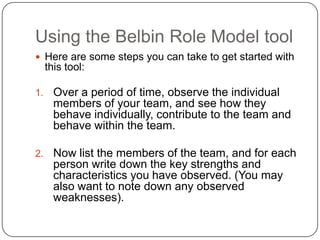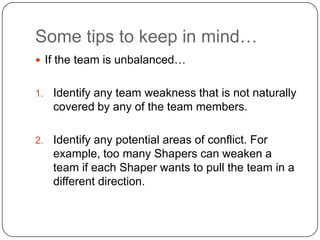Using Belbin’s Team Role Model
- 1. Make your team all it can be and more!!!Using Belbin’s Team Role Model
- 2. Topics to be discussed…Creating a more balanced teamUnderstanding Belbin’s team role modelAction Oriented RolesPeople Oriented RolesThought Oriented RolesUsing the Belbin Role Model tool
- 3. Creating a more balanced teamTeam performance is linked to… clearly defined responsibilitiesPlus every role needed is to perform the team’s goal is being performed fully and wellUnfortunately despite defined roles and responsibilities, a team falls short of it full potential
- 4. Ever have these happen on your teams:Some team members do not complete what you expected them to doTeam members lack flexibility so things fall through the cracksA valued expert on the team, does not see the bigger picture of their role, so tasks and steps are missed along the way that were expectedPerhaps one team members is upset at another team member’s approach to performing a task
- 5. Dr. Meredith Belbin made some keen observations…After observing teams working together for years, he made some unique observations:People on teams assume different “team roles:A “team role” is a tendency to behave, contribute and interrelate with others in a certain wayHe derived 9 roles from those he observed that people will fall underEach team role will determine the team’s success
- 6. Creating a more balanced teamBelbin suggests that… By understanding your team role within a particular teamYou can develop your strengths and manage your weaknesses as a team memberImprove how you contribute to the team
- 7. Creating a more balanced teamTeam Leader and Team Development Leaders will often use Belbin’s tool and approach to help create more balanced teams.NOTE:Teams can become unbalanced if all team members have similar styles of behavior or team roles.
- 8. Creating a more balanced teamEXAMPLES:If team members have similar weakness = The team as a whole may tend to have that weaknessIf team members have similar team strengths= They may tend to compete (rather than co-operate) for the team tasks and responsibilities that best suit their natural stylesSo you can use the model with your team to help ensure that necessary team roles are covered, and that potential behavioral tensions or weaknesses among the team member are addressed.
- 9. Some tips to keep in mind…Belbin's "team-roles" are based on observed behavior and interpersonal styles.Belbin suggests that people tend to adopt a particular team-role, bear in mind that your behavior and interpersonal style within a team is to some extent dependent on the situation: It relates not only to your own natural working style, but also to your interrelationships with others, and the work being done.
- 10. Some tips to keep in mind…Be careful: You, and the people you work with, may behave and interact quite differently in different teams or when the membership or work of the team changesAlso, be aware that there are other approaches in use, some of which complement this model, some of which conflict with it. By all means use this approach as a guide, however do not put too much reliance on it, and temper any conclusions with common sense.
- 11. Understanding Belbin’s team role modelBelbin identified nine team roles and he categorized those roles into three groups: Action OrientedPeople OrientedThought OrientedEach team role is associated with typical behavioral and interpersonal strengths.
- 12. Understanding Belbin’s team role modelBelbin also defined characteristic weaknesses that tend to accompany the team-roleHe called the characteristic weaknesses of team-roles the "allowable" weaknessesAs for any behavioral weakness, these are areas to be aware of and potentially improve.
- 13. Belbin’s Nine Team Roles are… Action OrientedShapers (SH)Implementer (IMP)Completer-Finisher (CF)People OrientedCoordinator (CO)Team Worker (TW)Resource Investigator (RI)Thought OrientedPlant (PL)Monitor-Evaluator (ME)Specialist (SP)
- 14. Let’s look at each role in its category in more detail…Action Oriented – Shapers (SH)Shapers…Challenge the team to improve. Dynamic and usually extroverted people who enjoy stimulating others, questioning norms, and finding the best approaches to problems. Shakes things up to make sure that all possibilities are considered and that the team does not become complacent.Shapers often see obstacles as exciting challenges and they tend to have the courage to push on when others feel like quitting.Potential weaknesses -- May be that they're argumentative, and that they may offend people's feelings.
- 15. Let’s look at each role in its category in more detail…Action Oriented – Implementer (IMP)Implementers…People who get things done. Turn the team's ideas and concepts into practical actions and plans. Typically conservative, disciplined people who work systematically and efficiently and are very well organized.These are the people who you can count on to get the job done.Potential weaknesses -- Implementers may be inflexible and somewhat resistant to change.
- 16. Let’s look at each role in its category in more detail…Action Oriented – Completer-Finisher (CF)Completer-Finishers…Are the people who see that projects are completed thoroughlyEnsure there have been no errors or omissions and they pay attention to the smallest of details. Very concerned with deadlines and will push the team to make sure the job is completed on timeDescribed as perfectionists who are orderly, conscientious, and anxious.Potential weaknesses -- May worry unnecessarily and find it hard to delegate.
- 17. Let’s look at each role in its category in more detail…People Oriented – Coordinator (CO)Coordinators…Take on the traditional team-leader role and have also been referred to as the chairpersonGuide the team to what they perceive are the objectives. Are often excellent listeners Are naturally able to recognize the value that each team members brings to the table. They are calm and good-natured and delegate tasks very effectively.Potential weaknesses -- May delegate away too much personal responsibility, and may tend to be manipulative.
- 18. Let’s look at each role in its category in more detail…People Oriented – Team Worker (TW)Team Workers…Are the people who provide support and make sure the team is working togetherThese people fill the role of negotiators within the team and they are flexible, diplomatic, and perceptive. Tend to be popular people who are very capable in their own right but who prioritize team cohesion and helping people getting along. Potential weaknesses -- May have a tendency to be indecisive, and maintain uncommitted positions during discussions and decision-making.
- 19. Let’s look at each role in its category in more detail…People Oriented – Resource Investigator (RI)Resource Investigators…Are innovative and curious. They explore available options, develop contacts, and negotiate for resources on behalf of the team. They are enthusiastic team members, who identify and work with external stakeholders to help the team accomplish its objective. They are outgoing and are often extroverted, meaning that others are often receptive to them and their ideas.Potential weaknesses -- May lose enthusiasm quickly, and are often overly optimistic.
- 20. Let’s look at each role in its category in more detail…Thought Oriented – Plant (PL)Plants…Is the creative innovator who comes up with new ideas and approaches. Thrive on praise but criticism is especially hard for them to deal with. Are often introverted and prefer to work apart from the team.Potential weaknesses -- Because their ideas are so novel, they can be impractical at times. They may also be poor communicators and can tend to ignore given parameters and constraints.
- 21. Let’s look at each role in its category in more detail…Thought Oriented – Monitor – Evaluator (ME)Monitors -- Evaluators…Best at analyzing and evaluating ideas that other people (often Plants) come up withAre shrewd and objective Carefully weigh the pros and cons of all the options before coming to a decision.Are critical thinkers and very strategic in their approach. They are often perceived as detached or unemotional. Potential weaknesses -- Sometimes they are poor motivators who react to events rather than instigating them
- 22. Let’s look at each role in its category in more detail…Thought Oriented – Specialist(SP)Specialists…Are people who have specialized knowledge that is needed to get the job done. Pride themselves on their skills and abilities, and they work to maintain their professional status. Their job within the team is to be an expert in the area, and they commit themselves fully to their field of expertise Potential weaknesses -- This may limit their contribution, and lead to a preoccupation with technicalities at the expense of the bigger picture.
- 23. Belbin’s Team Roles Tables
- 24. Using the Belbin Role Model toolThe Belbin Team Roles Model can be used in several ways:You can use it to think about team balance before a project startsYou can use it to highlight and so manage interpersonal differences within an existing teamYou can use it to develop yourself or others as a team player.
- 25. Using the Belbin Role Model toolHere are some steps you can take to get started with this tool:Over a period of time, observe the individual members of your team, and see how they behave individually, contribute to the team and behave within the team.Now list the members of the team, and for each person write down the key strengths and characteristics you have observed. (You may also want to note down any observed weaknesses).
- 26. Using the Belbin Role Model toolHere are some steps you can take to get started with this tool:Compare each person's listed strengths and weakness with the Belbin's descriptions of team-roles, and note the one that most accurately describes that person.Once you have done this for each team member, consider the following questions:Which team roles are missing from your team? And from this, ask yourself which strengths are likely to be missing from the team overall?Is there are prevalent team role that many of the team members share?
- 27. Some tips to keep in mind…With regard to prevalent team roles…Among teams of people that do the same job, a few team roles often prevail. For example, within a research department, the team roles of Specialist and Plant may prevail. A team of business consultants may mainly comprise Team Workers and Shapers. Such teams may be unbalanced, in that they may be missing key approaches and outlooks.
- 28. Some tips to keep in mind…If the team is unbalanced…Identify any team weakness that is not naturally covered by any of the team members. Identify any potential areas of conflict. For example, too many Shapers can weaken a team if each Shaper wants to pull the team in a different direction.
- 29. Using the Belbin Role Model toolOnce you have identified potential weakness, areas of conflict and missing strengths, consider the options you have to improve and change this.Consider:Whether an existing team member could compensate by purposefully adopting different a team role. With awareness and intention, this is sometimes possible.Whether one or more team members could improve how they work together and with others to avoid potential conflict of their natural styles.Whether new skills need to brought onto the team to cover weaknesses.
- 30. Closing remarks and thoughts…Remember not to depend too heavily on this idea when structuring your team – this is only one of many, many factors that are important in getting a team to perform at its best.That said, just knowing about the Belbin Team Roles model can bring more harmony to your team, as team members learn that there are different approaches that are important in different circumstances and that no one approach is best all of the time.

